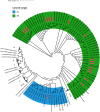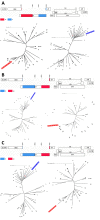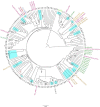Transmitted HIV drug resistance and subtype patterns among blood donors in Poland
- PMID: 34140600
- PMCID: PMC8211697
- DOI: 10.1038/s41598-021-92210-2
Transmitted HIV drug resistance and subtype patterns among blood donors in Poland
Abstract
Surveillance on the HIV molecular variability, risk of drug resistance transmission and evolution of novel viral variants among blood donors remains an understudied aspect of hemovigilance. This nationwide study analyses patterns of HIV diversity and transmitted resistance mutations. Study included 185 samples from the first time and repeat blood donors with HIV infection identified by molecular assay. HIV protease, reverse transcriptase and integrase were sequenced using population methods. Drug resistance mutation (DRM) patterns were analyzed based on the Stanford Interpretation Algorithm and standardized lists of transmitted mutations. Phylogeny was used to investigate subtyping, clustering and recombination patterns. HIV-1 subtype B (89.2%) followed by subtype A6 (7.6%) were predominant, while in three (1.6%) cases, novel recombinant B/A6 variants were identified. Non-B variants were more common among repeat donors (14.5%) compared to the first time ones (1.8%), p = 0.011, with higher frequency (9.9%) of A6 variant in the repeat donor group, p = 0.04. Major NRTI DRMs were observed in 3.8%, NNRTI and PI in 0.6% and INSTI 1.1% of cases. Additionally, E157Q polymorphism was observed in 9.8% and L74I in 11.5% of integrase sequences. Transmission of drug resistance among blood donors remains infrequent. Subtype patters increase in complexity with emergence of novel intersubtype A6B recombinants.
Conflict of interest statement
The authors declare no competing interests.
Figures





References
-
- Verhofstede C, et al. Phylogenetic analysis of the Belgian HIV-1 epidemic reveals that local transmission is almost exclusively driven by men having sex with men despite presence of large African migrant communities. Infect. Genet. Evol. 2018;61:36–44. doi: 10.1016/j.meegid.2018.03.002. - DOI - PubMed
Publication types
MeSH terms
Substances
LinkOut - more resources
Full Text Sources
Medical
Research Materials
Miscellaneous

